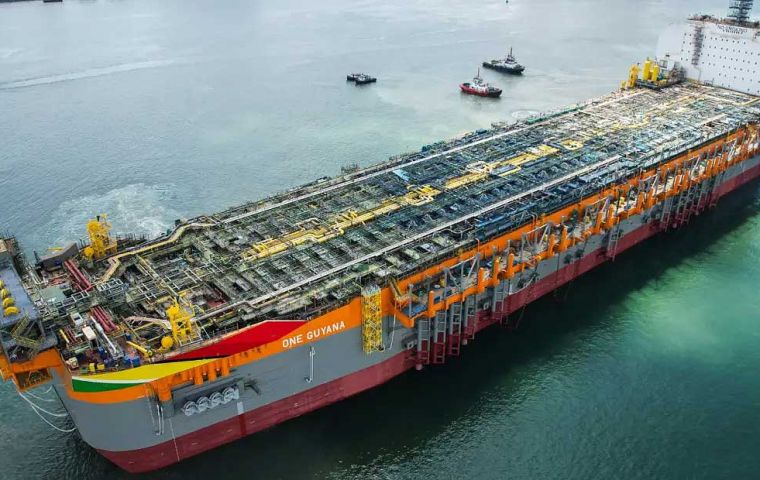MercoPress. South Atlantic News Agency
Guyana oil output breaking all oil exploration and production records
 Since January 2024, oil companies offshore Guyana are pumping over 600,000 barrels per day, with developments, completed at a scorching pace
Since January 2024, oil companies offshore Guyana are pumping over 600,000 barrels per day, with developments, completed at a scorching pace The impoverished South American country of Guyana is emerging as a major international oil producer and exporter. The former British colony is expected to become not only South America’s top oil producer but a key driver of world petroleum supply growth. The country has also become one of the fastest growing economies in the region, according to the World Bank and the Inter-American Development Bank
After decades of poor drilling results, Guyana has rapidly emerged as a significant global petroleum producer following a series of world class discoveries made by an Exxon-led consortium in the offshore 6.6 million acre Stabroek Block.
The block, where Exxon is the operator holding a 45% working interest with partners Hess and China-s CNOOC controlling 30% and 25%, respectively, is situated in Guyana’s territorial waters adjacent to the Esequibo region disputed by Venezuela. Since 2015, Exxon has made nearly 40 discoveries that are believed to contain at least 11 billion barrels of oil. The first discovery occurred in 2015 with the Liza-1 wildcat well, followed by the January 2017 Payara and Liza Deep discoveries, with the Liza 3 appraisal well found a 100 to 150-million-barrel reservoir below the existing Liza oilfield. It is speculated that the Stabroek Block contains well over 11 billion barrels of oil reserves, with the acreage possessing the potential to eclipse Brazil’s proven and probable reserves totaling 23 billion barrels, the second largest in South America.
The Liza Phase One project commenced operations in December 2019 with the start-up of the Liza Destiny floating production, storage and offloading (FPSO) vessel which can lift 120,000 barrels per day. Then, during February 2022, the Liza Phase 2 project was completed with the 220,000-barrel Liza Unity FPSO vessel commencing operations. By the end of November 2023, the Payara project was completed, with the 220,000 barrel-per-day Prosperity FPSO starting operations. This expanded the Stabroek Block’s capacity to 560,000 barrels per day. After enhancements, those facilities, since January 2024, have been pumping over 600,000 barrels per day. These developments, completed at a scorching pace, underscore that the Stabroek Block is a trillion opportunity for Exxon, its partners and Guyana.
In a stunning development, it took a mere four years for Guyana to go from the first defense discovery, , made in 2015 with Exxon’s Liza-1 exploration well, to the first oil in 2019. This is incredible because it usually takes a decade or longer for development of billion-dollar offshore energy projects. Indeed, industry data shows it takes, on average, seven years for an oilfield to reach production, with at least a quarter of projects taking even longer to achieve first oil. Deepwater offshore fields, depths of over 1,200 meters, like those developed in Guyana and Suriname, are among the most difficult and slowest to develop. Russia’s Crude Oil Shipments Slump.
In August 2024, Guyana’s Minister of Natural Resources, Vickram Bharrat, announced that the country’s oil reserves had grown by 600 million barrels to 11.6 billion barrels. This occurred because of Exxon’s latest oil discoveries in the prolific Stabroek Block. As a result, the South American country of less than one million now possesses the continent’s third largest oil reserves behind Brazil, which has proven reserves of around 16 billion barrels and Venezuela, with 303 billion barrels, the world’s largest. This abundance of high-quality discoveries in the Stabroek Block indicates that the Guyana Suriname Basin’s petroleum potential far exceeds the volumes calculated by the US Geological Survey, USGS.
The US agency determined the basin holds up to 33 billion barrels of crude oil, yet recent discoveries point to the basin’s true petroleum potential being significantly greater.
As Guyana’s energy investment inflows rise and oil reserves grow, production in the tiny South American country will expand as more discoveries are made and new projects come online. Exxon is developing four projects in the Stabroek Block scheduled for completion between 2024 and 2029. The first is the multi-billion-dollar 250,000 barrel-per-day Yellowtail development, which is expected to come online by the end of 2025. This will be followed by the Uaru and Whiptail projects, with both possessing the capacity to lift 250,000 barrels per day, which will start up in 2026 and 2027, respectively.
The final facility under construction is the Hammerhead project, which is expected to start lifting petroleum in 2029, adding 180,000 barrels per day to production in the Stabroek Block. Those facilities will add 930,000 barrels per day to Guyana’s oil production, lifting output to around 1.5 million barrels daily by the end of the decade. (Info from OilPrice and MP).




Top Comments
Disclaimer & comment rulesCommenting for this story is now closed.
If you have a Facebook account, become a fan and comment on our Facebook Page!